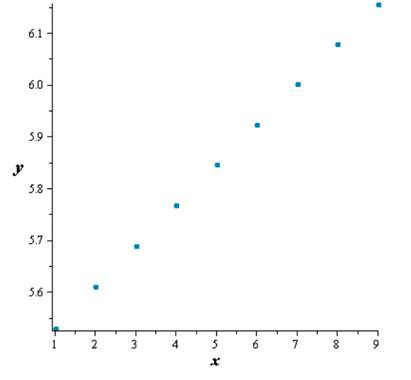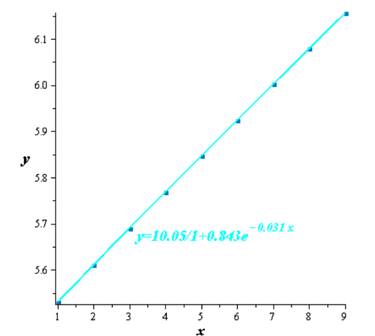
Concept explainers
(a)
To find: The
(a)
Answer to Problem 8AYU
The required graph is shown in Figure 1
Explanation of Solution
Given:
The given table is shown in table 1
Table 1
| Year | Population in Billions |
| 1993 | 5.531 |
| 1994 | 5.611 |
| 1995 | 5.691 |
| 1996 | 5.769 |
| 1997 | 5.847 |
| 1998 | 5.925 |
| 1999 | 6.003 |
| 2000 | 6.080 |
| 2001 | 6.157 |
Calculation:
Consider the population as dependent variable.
The scatter plot for the functions in table 1 is shown in Figure 1

Figure 1
(b)
To find: The logistic model from the given data.
(b)
Answer to Problem 8AYU
The logistic model is
Explanation of Solution
From the given data the logistic model is,
(c)
To find: The plot of the logistic model.
(c)
Answer to Problem 8AYU
The required plot is shown in Figure 2
Explanation of Solution
Given:
The given model is
Calculation:
Consider the given model is,
The required plot is shown in Figure 2

Figure 2
(d)
To find: The carrying capacity of the united states.
(d)
Answer to Problem 8AYU
The carrying capacity of the United Statesis
Explanation of Solution
Given:
The given model is
Calculation:
Consider the given model is,
Then, the carrying capacity of the United States is,
(e)
To find: The population of the united states in 2004.
(e)
Answer to Problem 8AYU
The population of the united states is
Explanation of Solution
Given:
The given model is
Calculation:
Consider the given model is,
Then, the population of the united states in 2004 is,
(f)
To find: The year in which the population of the United Statesis 7 billion.
(f)
Answer to Problem 8AYU
The required population is after
Explanation of Solution
Given:
The given model is
Calculation:
Consider the given model is,
Then, the population of the United States is 7 billion in,
(g)
To find: The comparison of the actual US census figure to the predicted one found in the part (e) and (f) and then discuss the differences.
(g)
Answer to Problem 8AYU
The population in year 2004 was 7.028 billion which differs 0.668 billion fom the predicted value of the population.
Explanation of Solution
The population in year 2004 was 7.028 billion which differs 0.668 billion fom the predicted value of the population.
Chapter 5 Solutions
Precalculus
Additional Math Textbook Solutions
Calculus: Early Transcendentals (2nd Edition)
Elementary Statistics
College Algebra with Modeling & Visualization (5th Edition)
Introductory Statistics
Pre-Algebra Student Edition
- A 20 foot ladder rests on level ground; its head (top) is against a vertical wall. The bottom of the ladder begins by being 12 feet from the wall but begins moving away at the rate of 0.1 feet per second. At what rate is the top of the ladder slipping down the wall? You may use a calculator.arrow_forwardExplain the focus and reasons for establishment of 12.4.1(root test) and 12.4.2(ratio test)arrow_forwarduse Integration by Parts to derive 12.6.1arrow_forward
- Explain the relationship between 12.3.6, (case A of 12.3.6) and 12.3.7arrow_forwardExplain the key points and reasons for the establishment of 12.3.2(integral Test)arrow_forwardUse 12.4.2 to determine whether the infinite series on the right side of equation 12.6.5, 12.6.6 and 12.6.7 converges for every real number x.arrow_forward
- use Corollary 12.6.2 and 12.6.3 to derive 12.6.4,12.6.5, 12.6.6 and 12.6.7arrow_forwardExplain the focus and reasons for establishment of 12.5.1(lim(n->infinite) and sigma of k=0 to n)arrow_forwardExplain the focus and reasons for establishment of 12.5.3 about alternating series. and explain the reason why (sigma k=1 to infinite)(-1)k+1/k = 1/1 - 1/2 + 1/3 - 1/4 + .... converges.arrow_forward
 Calculus: Early TranscendentalsCalculusISBN:9781285741550Author:James StewartPublisher:Cengage Learning
Calculus: Early TranscendentalsCalculusISBN:9781285741550Author:James StewartPublisher:Cengage Learning Thomas' Calculus (14th Edition)CalculusISBN:9780134438986Author:Joel R. Hass, Christopher E. Heil, Maurice D. WeirPublisher:PEARSON
Thomas' Calculus (14th Edition)CalculusISBN:9780134438986Author:Joel R. Hass, Christopher E. Heil, Maurice D. WeirPublisher:PEARSON Calculus: Early Transcendentals (3rd Edition)CalculusISBN:9780134763644Author:William L. Briggs, Lyle Cochran, Bernard Gillett, Eric SchulzPublisher:PEARSON
Calculus: Early Transcendentals (3rd Edition)CalculusISBN:9780134763644Author:William L. Briggs, Lyle Cochran, Bernard Gillett, Eric SchulzPublisher:PEARSON Calculus: Early TranscendentalsCalculusISBN:9781319050740Author:Jon Rogawski, Colin Adams, Robert FranzosaPublisher:W. H. Freeman
Calculus: Early TranscendentalsCalculusISBN:9781319050740Author:Jon Rogawski, Colin Adams, Robert FranzosaPublisher:W. H. Freeman
 Calculus: Early Transcendental FunctionsCalculusISBN:9781337552516Author:Ron Larson, Bruce H. EdwardsPublisher:Cengage Learning
Calculus: Early Transcendental FunctionsCalculusISBN:9781337552516Author:Ron Larson, Bruce H. EdwardsPublisher:Cengage Learning





